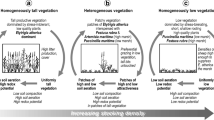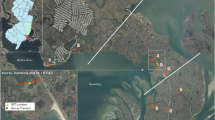Abstract
Grazing an abandoned salt marsh causes retrogressive succession, since mid salt-marsh communities change into lower salt-marsh communities. Grazing and mowing are compared in detail. Both management practices enhance species diversity in an abandoned salt marsh. This can be attributed to the removal of litter. The finding that lower salt-marsh species appear more with grazing than with mowing or abandoning is not related to a higher soil salinity as compared to mowing or abandoning, but probably to locally baring of the soil by grazing animals. Only species of pioneer or unstable environments seem to have a persistent seed bank, for other species seed dispersal seems to be a limiting factor for their establishment.
Similar content being viewed by others
References
Ahmad, I. & Wainwright, S. J., 1977. Tolerance to salt, partial anaerobiosis, and osmotic pressure in Agrostis stolonifera. New Phytol. 79: 605–612.
Bakker, J. P., 1978. Changes in a salt marsh vegetation as a result of grazing and mowing—a five-year study of permanent plots. Vegetatio 38: 77–87.
Bakker, J. P., 1983. Seed bank and species diversity in moist grassland communities. Acta Bot. Neerl. 32: 246.
Bakker, J. P. & Ruyter, J. C., 1981. Effects of five years of grazing on a salt marsh vegetation. Vegetatio 44: 81–100.
Beeftink, W. G., 1965. De zoutvegetatie van Z.W.-Nederland, beschouwd in Europees verband. Thesis. Meded. Landbouwhogeschool Wageningen 65: 1–167.
Beeftink, W. G., 1977a. Salt marshes. In: R. S. K. Barnes (ed.), The Coastline, pp. 93–121. Wiley, London.
Beeftink, W. G., 1977b. The coastal salt marshes of western and northern Europe: an ecological and phytosociological approach. In: V. J. Chapman (ed.), Wet Coastal Ecosystems, pp. 109–155. Elsevier, Amsterdam.
Brereton, A. J., 1971. The structure of the species populations in the initial stage of salt marsh succession. J. Ecol. 59: 321–338.
Davy, A. J. & Watkinson, A. R., 1984. Population biology of salt marsh and sand dune annuals. In: W. G. Beeftink, J. Rozema & A. H. Huiskes (eds.), Ecology of Coastal Vegetation. Vegetatio 59/60: 000–100.
Duuren, L. van, Bakker, J. P. & Fresco, L. F. M., 1981. From intensively agricultural practices to hay-making without fertilization. Vegetatio 47: 241–258.
Fresco, L. F. M., 1971. Compound analysis: a preliminary report of a new numerical approach in phytosociology. Acta Bot. Neerl. 20: 589–599.
Gray, A. J. & Scott, R., 1977. The ecology of Morecambe Bay VII. The distribution of Puccinellia maritima, Festuca rubra and Agrostis stolonifera in the salt marshes. J. Appl. Ecol. 14: 229–241.
Grime, J. P., 1979. Plant Strategies and Vegetation Processes. Wiley, Chichester. 222 pp.
Hansen, D., 1982. Entwicklung und Beeinflussung der Nettoprimär produktion auf Vorlandflächen und im Vogelschutzgebiet Hauke-Haien-Koog. Schriftenreihe Inst. Wasserw. und Landschaftsökologie Christian-Albr.-Univ. Kiel 1: 1–273.
Heukels, H. & Ooststroom, S. J. van, 1977. Flora van Nederland. Wolters-Noordhoff, Groningen. 925 pp.
Ijjas, I., 1969. Effect of compactness and initial moisture content of the soil on the process of capillary rise. In: P. E. Sijsema & H. Wassink (eds.), Water in the Unsaturated Zone, pp. 547–559. Proceedings IASH-Unesco Symposium, Wageningen.
Jerling, L., 1982. Population dynamics of a perennial herb (Plantago maritima) along a distributional gradient—a demographic study. Thesis, University of Stockholm.
Kauppi, M., 1967. Ueber den Einfluss der Beweidung auf die Vegetation der Uferwiesen an der Bucht Liminganlahti im Nordteil des Bottnischen Meerbusens. Aquilo Ser. Bot. 6: 347–369.
Looyen, R. C., 1984. Grazing pressure and vegetation dynamics at the Oosterkwelder salt marsh on Scheirmonnikoog. Acta Bot. Neerl. 33: 360–361.
Milton, W. E. J., 1939. The occurrence of buried viable seeds in soils at different elevations and on a salt marsh. J. Ecol. 27: 149–159.
Pielou, E. C., 1966. The measurement of diversity in different types of biological collections. J. Theor. Biol. 13: 131–144.
Ranwell, D. S., 1972. Ecology of Salt Marshes and Sand Dunes. Chapman & Hall, London. 258 pp.
Rozema, J., 1978. On the ecology of some halophytes from a beach plain in the Netherlands. Thesis, Free University of Amsterdam. 188 pp.
Schmeisky, H., 1974. Vegetationskundliche und ökologische Untersuchungen in Strandrasen des Graswarders vor Heiligenhafen, Ostsee. Thesis, University of Göttingen. 103 pp.
Siira, J., 1970. Studies in the ecology of the seashore meadows of the Bothnian Bay with special reference to the Liminka area. Aquilo Ser. Bot. 9: 1–109.
Thompson, J. & Grime, J. P., 1979. Seasonal variation in the seed banks of herbaceous species in ten contrasting habitats. J. Ecol. 67: 893–921.
Waisel, Y., 1972. Biology of Halophytes. Academic Press, London. 395 pp.
Wells, T. C. E., 1971. A comparison of the effects of sheep grazing and mechanical cutting on the structure and botanical composition of chalk grassland. In: E. Duffey & A. S. Watt (eds.), The Scientific Management of Animal and Plant Communities for Conservation, pp. 497–516. Blackwell, Oxford.
Westhoff, V., 1947. The vegetation of dunes and salt marshes on the Dutch islands of Terschelling, Vlieland and Texel. Thesis, University of Utrecht. 131 pp.
Westhoff, V. & Held, A. J. den, 1969. Plantengemeenschappen in Nederland. Thieme, Zutphen. 324 pp.
Westhoff, V. & Sykora, K. V., 1979. A study of the influence of desalinization on the Juncetum gerardii. Acta Bot. Neer. 28: 505–512.
Author information
Authors and Affiliations
Additional information
Nomenclature follows Heukels & van Ooststroom (1977) for species; Westhoff & den Held (1969) for syntaxa.
Mrs R. Rusthoven analyzed the soil samples, Mr E. Leeuwinga drawed the figures, and Mrs J. O'Brien corrected the English text.
Rights and permissions
About this article
Cite this article
Bakker, J.P. The impact of grazing on plant communities, plant populations and soil conditions on salt marshes. Vegetatio 62, 391–398 (1985). https://doi.org/10.1007/BF00044766
Accepted:
Issue Date:
DOI: https://doi.org/10.1007/BF00044766




